List of non-marine molluscs of Peru
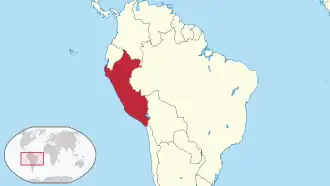
The non-marine molluscs of Peru are a part of the molluscan fauna of Peru (wildlife of Peru).
A number of species of non-marine molluscs are found in the wild in Peru.
There are 852 species of gastropods (89 species of freshwater gastropods,[1] 763 species of land gastropods)[1] and 40 species of freshwater bivalves living in the wild.[1]
There is altogether 129 species of freshwater molluscs in Peru.[1]
| Numbers of molluscs by habitat | Number of species |
|---|---|
| Freshwater gastropods | 89[1] |
| Land gastropods | 763[1] |
| Total number of non-marine gastropods | 852 |
| Freshwater bivalves | 40[1] |
| Total number of non-marine molluscs | 892 |
Freshwater gastropods
Freshwater gastropods include:
- Pomacea haustrum (Reeve, 1856)[2]
- Biomphalaria andecola (Orbigny, 1835)[3]
- Biomphalaria helophila (Orbigny, 1835)[3]
- Biomphalaria peregrina (Orbigny, 1835) - synonym: Biomphalaria pucaraensis (Preston, 1909)[3]
- Biomphalaria tenagophila (Orbigny, 1835)[3]
- Drepanotrema kermatoides (Orbigny, 1835)[3]
- Drepanotrema limayanum (Lesson, 1830)[3]
- Helisoma trivolvis (Say, 1817)[3]
- Helisoma duryi (Wetherby, 1879)[3]
- Lymnaea viatrix Orbigny, 1835[3]
- Physa acuta Draparnaud, 1801[3]
- seemingly Physa peruviana Gray, 1828[3]
Land gastropods

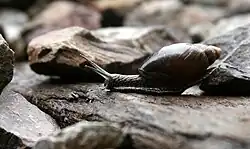
There are other 30 genera of land gastropods, than mentioned below next to families, with 56 species.[1]
Helicinidae - 2 genera, 25 species[1]
- ...
Neocyclotidae - 4 genera, 20 species[1]
- ...
Orthalicidae - without Bulimulinae has 4 genera and 18 species in Peru.[1]
- ...
Orthalicidae, Bulimulinae - only Bulimulinae has 15 genera, 424 species in Peru[1]
- ...
- Colosius pulcher (Colosi 1921)[4]
- Heterovaginina limayana (Lesson 1830)[4]
- Latipes lisei Thomé & Gomes 1999[4]
- Montivaginulus coriaceus (Kraus 1954)[4]
- Novovaginula carinata (Thiele 1927)[4]
- Novovaginula rosaneae Thomé & Gomes 1999[4]
- Phyllocaulis gayi (Fischer 1871)[4]
- Sarasinula marginata (Semper, 1885)[5][4]
Subulinidae - 5 genera, 19 species[1]
- Leptinaria unilamellata (d'Orbigny, 1837)[5]
Clausiliidae - 14 genera, 75 species[1]
- ...
Scolodontidae - 8 genera, 55 species[1]
- ...
Charopidae - 3 genera, 13 species[1]
- ...
Pleurodontidae - 2 genera, 13 species[1]
- ...
Camaenidae - 2 genera, 12 species
- ...
Helminthoglyptidae - 2 genera, 33 species[1]
- ...
Freshwater bivalves
Freshwater bivalves include:
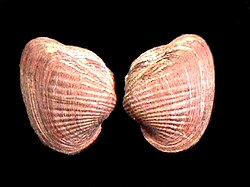
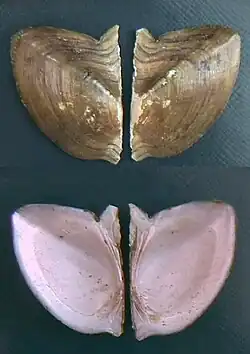
- Callonaia duprei (Recluz, 1843)[1]
- Castalia ambigua Lamarck, 1819 - Castalia ambigua ambigua Lamarck, 1819[1]
- Castalia multisulcata Hupé, 1857[1]
- Castalia schombergiana Sowerby, 1869[1]
- Castalia sulcata - Castalia sulcata orbygnyi Hupé & Deville, 1850[1]
- Diplodon limensis (Kust-Chemnitz, 1851)[1]
- Diplodon obsolescens Baker, 1914[1]
- Diplodon suavidicus (Lea, 1856)[1]
- Diplodontites cookei Kust & Chemnitz, 1851[1]
- Paxyodon syrmathophorus Meuschen, 1781[1]
- Prisodon obliquus Schumacher, 1817[1]
- Triplodon corrugatus (Lamarck, 1819)[1]
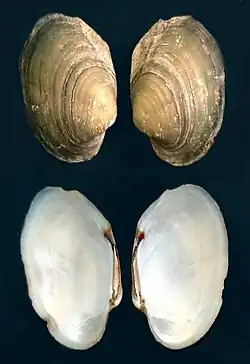
- Anodonta solidula Lamarck, 1819[1]
- Anodonta subsinuata Phillippi, 1869[1]
- Anodonta subrostrata Phillippi, 1869[1]
- Anodonta ucayalensis Phillippi, 1869[1]
- Anodontites elongatus (Swainson, 1823)[1]
- Anodontites ensiformis (Spix & Wagner, 1827)[1]
- Anodontites incarum (Philippi, 1869)[1]
- Anodontites tenebricosa (Lea, 1834)[1]
- Anodontites trapesialis (Lamarck, 1819) - Anodontites trapesialis trapesialis (Lamarck, 1819)[1]
- Anodontites trapezeus (Spix, 1827)[1]
- Anodontites trigonus (Spix, 1827) - Anodontites trigonus trigonus (Spix, 1827)[1]
- Anodontites weirauchi Hass, 1930[1]
- Iheringiella sp.[1]
- Leila blainvilliana (Lea, 1834)[1]
- Leila esula (Orbigny, 1835)[1]
- Monocondylaea semisulcata Adams, 1870[1]
- Mycetopoda siliquosa Spix, 1827[1]
- Mycetopoda soleniformis Orbigny, 1835[1]
- Mycetopodella falcata (Higgins, 1868)[1]
- Tamsiella sp.[1]
- Barlettia stefanensis (Moricand, 1856)[1]
- Eupera simoni Jousseaume, 1889[1]
- Eupera primei Klappenbach, 1967[1]
- Pisidium meierbrooki Kuiper & Hinz, 1983[1]
- Sphaerium forbesii Philippi, 1869[1]
- Sphaerium lauricocheae Philippi, 1870[1]
- Sphaerium titicacence (Pilsbry, 1924)[1]
See also
- List of marine molluscs of Peru
Lists of molluscs of surrounding countries:
- List of non-marine molluscs of Ecuador, Wildlife of Ecuador
- List of non-marine molluscs of Colombia, Wildlife of Colombia
- List of non-marine molluscs of Brazil, Wildlife of Brazil
- List of non-marine molluscs of Bolivia, Wildlife of Bolivia
- List of non-marine molluscs of Chile, Wildlife of Chile
References
- ^ a b c d e f g h i j k l m n o p q r s t u v w x y z aa ab ac ad ae af ag ah ai aj ak al am an ao ap aq ar as at au av aw ax ay az ba bb bc bd be bf (in Spanish) Ramírez R., Paredes C. & Arenas J. (2003). "Moluscos del Perú". Revista de Biología Tropical 51(3): 225-284. PDF Archived 2012-09-23 at the Wayback Machine
- ^ Rawlings T. A., Hayes K. A., Cowie R. H. & Collins T. M. (2007). "The identity, distribution, and impacts on non-native apple snails in the continental United States". BMC Evolutionary Biology 7: 97 doi:10.1186/1471-2148-7-97.
- ^ a b c d e f g h i j k Paraense W. L. (September 2003) "Planorbidae, Lymnaeidae and Physidae of Peru (Mollusca: Basommatophora)". Memórias do Instituto Oswaldo Cruz 98(6): 767-771. PDF
- ^ a b c d e f g h Thomé, José Willibaldo; Rodrigues Gomes, Suzete; Souza da Silva, Rosane (2001). "Illustrierte und kommentierte Liste der Veronicellidae von Peru (Mollusca: Gastropoda)". Archiv für Molluskenkunde 129(1-2): 69-75. DOI: 10.1127/arch.moll/129/2001/69
- ^ a b Robinson D. G., Hovestadt A., Fields A. & Breure A. S. H. (July 2009). "The land Mollusca of Dominica (Lesser Antilles), with notes on some enigmatic or rare species". Zoologische Mededelingen 83 http://www.zoologischemededelingen.nl/83/nr03/a13 Archived 2011-10-07 at the Wayback Machine
External links
- Paredes C., Huamán P., Cardoso F., Vivar R. & Vera V. (1999). "Estado actual del conocimiento de los moluscos acuáticos en el Perú". Revista Peruana de Biología 6(1): 5-47. doi:10.15381/rpb.v6i1.8298.